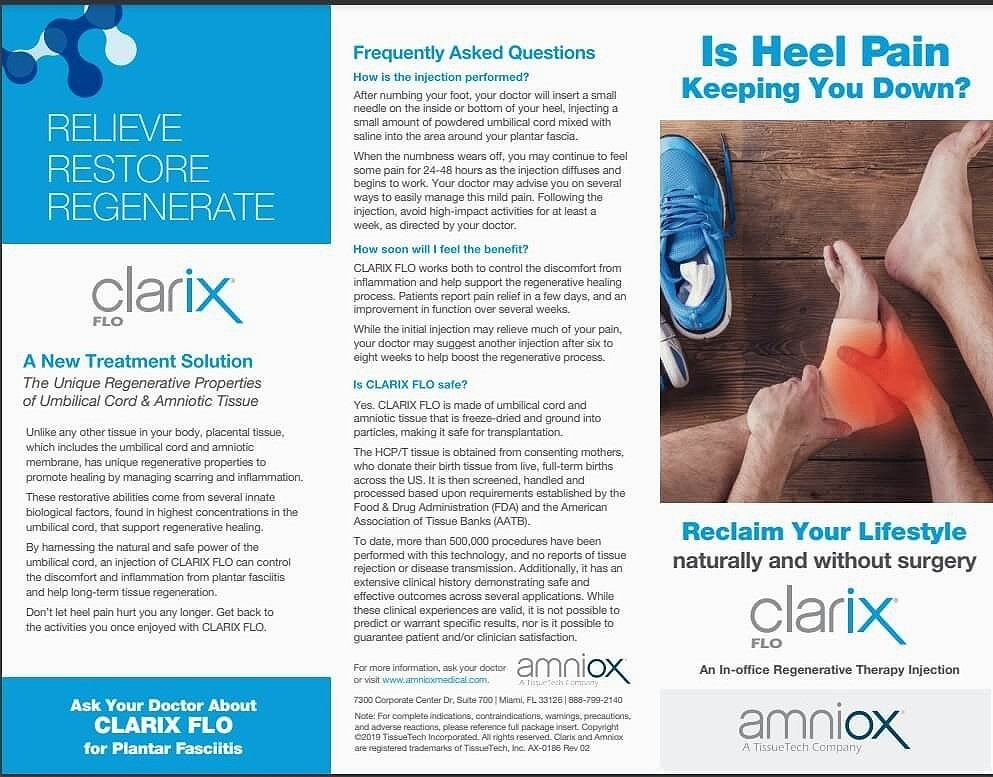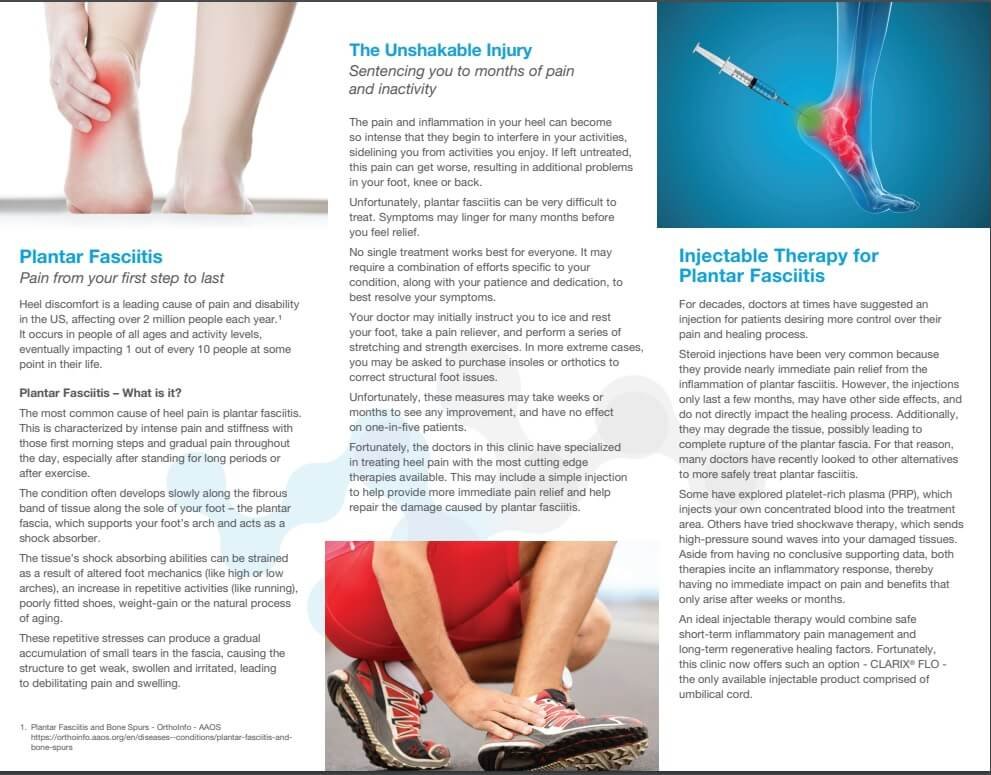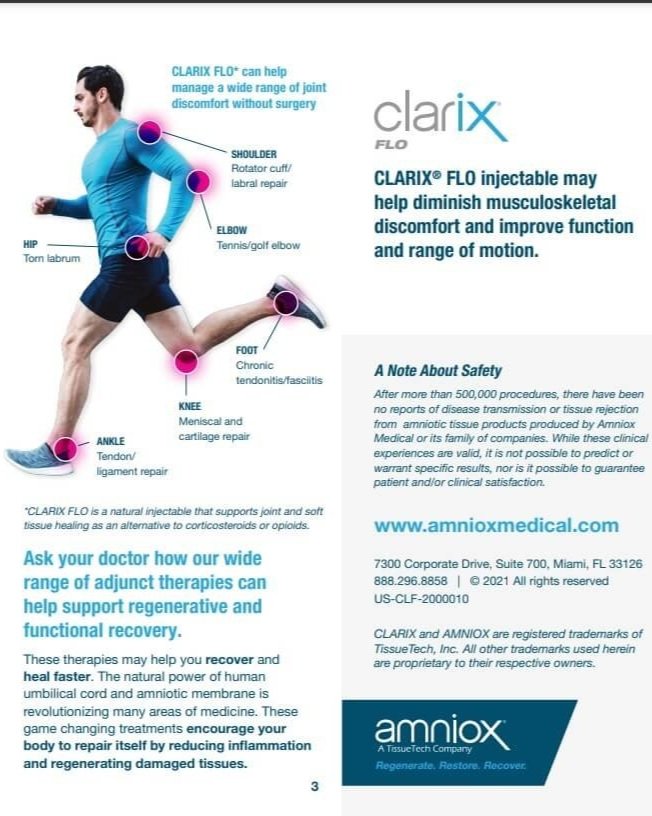REGENERATIVE MEDICINE SPECIALIST
Podiatrist, Foot Surgeon serving Miami and Hialeah, FL area
CLARIX® FLO
Is heel pain getting you down?
Introducing Clarix Flo! The Unique Regenerative Properties of Umbilical Cord & Amniotic Tissue An In-office Regenerative Therapy Injection
PerfectFeetCare Podiatry Centers utilizes the latest in non-invasive medical advancements to help our patients avoid surgery and obtain pain relief from Plantar Fasciitis, Heel Pain, Tendonitis, difficult to heal wounds. Also faster rehabilitation after surgery.
RELIEVE
RESTORE
REGENERATE
A NEW TREATMENT SOLUTION
THE UNIQUE REGENERATIVE PROPERTIESOF UMBILICAL CORD & AMNIOTIC TISSUE
Unlike any other tissue in your body, placental tissue, which includes the umbilical cord and amniotic membrane, has unique regenerative properties to promote healing by managing scarring and inflammation.
These restorative abilities come from several innate biological factors, found in highest concentrations in the umbilical cord, that support regenerative healing.
By harnessing the natural and safe power of the umbilical cord, an injection of CLARIX FLO can control the discomfort and inflammation from plantar fasciitis and help long-term tissue regeneration.
Don’t let heel pain hurt you any longer. Get back to the activities you once enjoyed with CLARIX FLO.
PLANTAR FASCIITIS
PAIN FROM YOUR FIRST STEP TO LAST
Heel discomfort is a leading cause of pain and disability in the US, affecting over 2 million people each year. It occurs in people of all ages and activity levels, eventually impacting 1 out of every 10 people at somepoint in their life.
The most common cause of heel pain is plantar fasciitis. This is characterized by intense pain and stiffness with those first morning steps and gradual pain throughout the day, especially after standing for long periods or after exercise.
The condition often develops slowly along the fibrous band of tissue along the sole of your foot – the plantar fascia, which supports your foot’s arch and acts as a shock absorber.
The tissue’s shock absorbing abilities can be strained as a result of altered foot mechanics (like high or low arches), an increase in repetitive activities (like running), poorly fitted shoes, weight-gain or the natural process of aging.
These repetitive stresses can produce a gradual accumulation of small tears in the fascia, causing the structure to get weak, swollen and irritated, leading to debilitating pain and swelling.
THE UNSHAKABLE INJURY SENTENCING YOU TO MONTHS OF PAIN AND INACTIVITY
The pain and inflammation in your heel can become so intense that they begin to interfere in your activities, sidelining you from activities you enjoy. If left untreated, this pain can get worse, resulting in additional problems in your foot, knee or back.
Unfortunately, plantar fasciitis can be very difficult to treat. Symptoms may linger for many months before you feel relief.
No single treatment works best for everyone. It may require a combination of efforts specific to your condition, along with your patience and dedication, to best resolve your symptoms.
Your doctor may initially instruct you to ice and rest your foot, take a pain reliever, and perform a series of stretching and strength exercises. In more extreme cases, you may be asked to purchase insoles or orthotics to correct structural foot issues.
Unfortunately, these measures may take weeks or months to see any improvement, and have no effect on one-in-five patients.
Fortunately, the doctors in this clinic have specialized in treating heel pain with the most cutting edge therapies available. This may include a simple injection to help provide more immediate pain relief and help repair the damage caused by plantar fasciitis.
INJECTABLE THERAPY FOR PLANTAR FASCIITIS
For decades, doctors at times have suggested an injection for patients desiring more control over their pain and healing process.
Steroid injections have been very common because they provide nearly immediate pain relief from the inflammation of plantar fasciitis. However, the injection sonly last a few months, may have other side effects, and do not directly impact the healing process. Additionally, they may degrade the tissue, possibly leading to complete rupture of the plantar fascia. For that reason, many doctors have recently looked to other alternatives to more safely treat plantar fasciitis.
Some have explored platelet-rich plasma (PRP), which injects your own concentrated blood into the treatment area. Others have tried shockwave therapy, which sends high-pressure sound waves into your damaged tissues. Aside from having no conclusive supporting data, both therapies incite an inflammatory response, thereby having no immediate impact on pain and benefits that only arise after weeks or months.
An ideal injectable therapy would combine safe short-term inflammatory pain management and long-term regenerative healing factors. Fortunately, this clinic now offers such an option - CLARIX® FLO -the only available injectable product comprised of umbilical cord.
FREQUENTLY ASKED QUESTIONS
-
After numbing your knee, your doctor will insert a small needle to inject a small amount of powdered umbilical cord mixed with saline directly into the knee joint.
When the numbness wears off, you may continue to feel some pain for 24-48 hours as the injection diffuses and begins to work. Your doctor may advise you on several ways to easily manage this mild pain. Following the injection, avoid high-impact activities for at least a week, as directed by your doctor.
-
CLARIX FLO works both to control the discomfort from inflammation and help support the regenerative healing process. Patients report pain relief in a few days, and an improvement in function over several weeks. While the initial injection may relieve much of your pain, your doctor may suggest another injection after six to eight weeks to help boost the regenerative process.
-
Yes. CLARIX FLO is made of umbilical cord and amniotic tissue that is freeze-dried and ground into particles, making it safe for transplantation.
The HCT/P tissue is obtained from consenting mothers, who donate their birth tissue from live, full-term births across the US. It is then screened, handled and processed based upon requirements established by the Food & Drug Administration (FDA) and the American Association of Tissue Banks (AATB).
To date, more than 500,000 procedures have been performed with this technology, and no reports of tissue rejection or disease transmission. Additionally, it has an extensive clinical history demonstrating safe and effective outcomes across several applications. While these clinical experiences are valid, it is not possible to predict or warrant specific results, nor is it possible to guarantee patient and/or clinician satisfaction.





